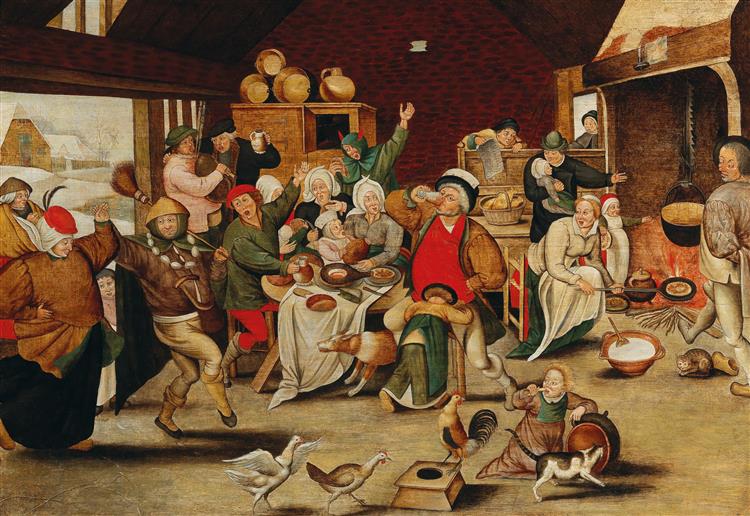Описание
Pieter Brueghel the Younger's The King Drinks is an evocative depiction of pleasure, authority, and the consequences of excess. Painted in the 17th century, this work is a testament to the distinctive style of Brueghel the Younger, who, while inspired by his father, Pieter Brueghel the Elder, developed an aesthetic of his own that resonated with the everyday life and mores of society of his time. In this painting, the artist not only captures a moment in time, but also offers a social critique hidden within the bustling festive atmosphere.
The compositional focus revolves around the central figure of the king, highlighted by his large golden goblet. The king, who appears to command the scene, is placed in a prominent position, surrounded by a lively crowd. His attitude seems to exemplify the hedonism of the period, suggesting both celebration and the inevitable decadence that can arise from debauchery. The expression on his face and the forward lean of his body suggest a state of intoxication and complacency, so typical of a monarch in the midst of a feast. In contrast, the dynamic, character-filled setting plays a crucial role in the visual narrative, where a panoply of emotions is seen: overflowing joy, laughter, and, in some cases, a shadow of discontent.
The colour palette used by Brueghel the Younger is rich and vibrant, highlighting warm tones that invite one to immerse oneself in the festive atmosphere. Ochres, reds and greens combine effectively and create a visual vibrancy that is almost palpable. The attention to detail in the characters’ clothing and the decoration of the surroundings adds a layer of realism that connects the viewer with the period depicted. This interaction between a king and his subjects can be interpreted as a representation of power dynamics and the role of the ruler in society.
Scanning the crowd surrounding the king, one sees a diversity of figures, from nobles to peasants, all equally immersed in the festivities. This mix of social status reflects a broader view of humanity, suggesting that the pleasure of wine and celebration transcends class barriers. However, the gaze of some characters may reflect disdain or warning, implying that not everyone shares the same joy and that the party may also be a refuge from underlying problems.
It is interesting to note that Pieter Brueghel the Younger was known for repeating many of his father's compositions, though sometimes with significant variations. This work, though based on his own interpretation, exhibits a style similar to his father's, combining social satire with a critique of human behavior, concepts present in other works by both artists. Brueghel's treatment of festive scenes indicates a particular interest in narrating the human condition, marked by an often jaundiced tone that shows both joy and its dangers.
The painting, “The King Drinks,” is not only an eye-catcher, but also a thought-provoking socio-political commentary on the ephemeral nature of power and pleasure. In terms of its placement within the art canon, “The King Drinks” serves as a superb example of 17th-century Flemish art, which foregrounds humanity in everyday life, giving each figure and each action its own story and meaning. As we stand before this work, we are challenged not only to observe, but to question the balance between authority, celebration, and the inevitable cost of indulgence.
KUADROS ©, a famous painting on your wall.
Hand-made oil painting reproductions, with the quality of professional artists and the distinctive seal of KUADROS ©.
Painting reproduction service with satisfaction guarantee. If you are not completely satisfied with the replica of your painting, we will refund 100% of your money.

